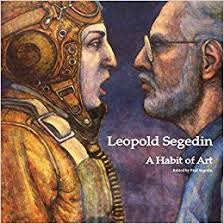Book Review: Leopold Segedin: A Habit of Art
 Sunday, March 3, 2019 at 8:18PM
Sunday, March 3, 2019 at 8:18PM  Leopold Segedin: A Habit of Art. Leopold Segedin (Author). Paul Segedin and Benjamin Segedin (Editors). Chicago: Outbound Ike Publishing, 2018, Hardcover, 130 pages.
Leopold Segedin: A Habit of Art. Leopold Segedin (Author). Paul Segedin and Benjamin Segedin (Editors). Chicago: Outbound Ike Publishing, 2018, Hardcover, 130 pages.
Reviewed by Greg Borzo.
In an Allan Bennett play, an elderly artist named W.H. Auden said, “Am I dead? I work. I have the habit of art.” This quote inspired the title of this book. Such a habit—a stubborn, driving need to paint—compels Leopold Segedin to climb up to his attic virtually every day to create art. His sons, Paul and Ben, recently installed grab bars so their 92-year-old father could pull himself up to his studio—a scene he depicts in several of his paintings as a Sisyphean struggle.
“It’s work. It’s a pain in the ass. But I paint because I have something meaningful to say,” Segedin told Jay Shefsky during a 2013 episode of “Jay’s Chicago” on WTTW-TV
What an understatement! Judging from this new book, Leopold Segedin: A Habit of Art, Segedin has much to say—through his words and paintings—about many topics, particularly aging, the passage of time, being Jewish, and his sweet home Chicago.
The theme of Chicago comes through the strongest in this beautiful coffee-table book. Many of Segedin’s paintings, reproduced in striking quality, portray Chicago with a distinctive bearing and appealing style, depicting littered streets, cracked sidewalks, rundown “L” platforms, and modest buildings with rich tones and pleasant colors. Some of the street scenes are empty while others are chock full of people rushing somewhere but not interacting with each other, a touch that brings to mind the work of Pieter Bruegel the Elder.Many of these urban paintings depict windows and doors, wallpaper and ghost signs, brick walls and iron tracks. Glowing in the afternoon sunlight, these objects reverberate with rich detail.
While Segedin’s Chicago paintings might happily hang in anyone’s home, many of his other paintings are captivating yet disturbing. Some show menacing kings and ominous priests; others show troubled faces and muddled motifs. His Holocaust paintings are hard to shake. Segedin notes that he wrestled most of his life with “how to give form to the Holocaust without trivializing it.” His work depicting dehumanized forms, dismembered body parts, discarded suits of clothing, and frozen screams succeed—all too well. “People were hollering, they were crying, and nobody heard,” he said in the note accompanying one such painting.
Segedin continued these themes in paintings he created in response to the Vietnam War. Human beings, represented by organic shapes, conflicted with institutions, represented by geometric shapes. His painting, Parliament of Man, is an ode to snakes and soldiers, power and might. “The responsivelessness of politicians and leaders . . . repeats itself indefinitely,” Segedin writes.
Images of Segedin himself appear throughout the book, often repeatedly in the same painting. The self-portraits at different stages of his life reflect his fixation with aging. Mortality changes as you age into “something you look back on,” he writes. “I’m still startled when the adolescent kid that I still am in my mind’s eye looks into the morning mirror and sees an old man.”
The artist’s notes, which accompany his paintings, are one of the most absorbing aspects of this book. While Segedin’s paintings speak for themselves, it’s fascinating—and rare—to read what an artist has to say about his own paintings. Museums are full of “untitled” works that leave you on your own. Not here. Notes supplement most of the paintings, providing perspective and reflection. The notes were derived from interviews with Segedin, first by Richard Cahan, a co-publisher of CityFiles Press, and later by sons Paul and Ben.
How fitting that his sons made this long-overdue book happen, as Segedin is known for saying that there are only two miraculous things in life: children and art!
 Windy City Reviews | Comments Off |
Windy City Reviews | Comments Off | 